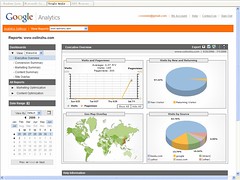If you haven’t started thinking about analytics yet, check out our intro to online analytics for small businesses. Once you understand what analytics are and why you need them, we can get started on how to use them for your business.
More Isn’t Merrier
The beauty of online marketing is that you can measure almost anything. However, just because you can measure everything doesn’t mean you should. Interpreting the results from your analytics is time consuming, and time is your most important resource!
There are lots of tools available to measure analytics for small businesses – for your website or blog we recommend using Google Analytics, which is free. To help you get started, we’ve put together a quick overview of 2 analytics to measure for each part of your inbound marketing campaign. This isn’t a complete list, however it’s a great overview to get you started.
1. Analytics For Your Blog
Blog Traffic + Referral Sources: Blog traffic and referral sources measure how many people are reading your blog and how they’re finding your articles. Did they discover a post on social media, while doing a search on Google or through an email campaign?
It’s helpful to know how people are finding you so you can learn what’s working. And remember, if you’re lacking traffic from a certain area you can put more effort into that channel, or realize that it might not be a good fit for your business, and focus on more productive aspects of your online marketing campaign.
Individual Post Views: You can see which articles are viewed the most and try to pick out some trends. Were they on a similar topic? Posted on similar days at similar times? Short or long? Did you share them on social media? Respond quickly to comments? Make sure your keywords were positioned properly? You get the idea. Once you discover what your readers like, you’ll have a better understanding of what to focus on to improve your blog!
2. Analytics For Your Keyword Research
Keyword Performance + Rankings: Keep track of how your pages are ranking for the words you want to compete for. If you aren’t ranking well despite writing consistent optimized blog posts, try different keywords. There’s no perfect solution – sometimes you have to keep throwing mud at the wall and see what sticks!
Organic Search Traffic: This is the number of people who come to your site through organic searches. Essentially, this is what keyword research is all about. If you see a lot of traffic from a particular keyword, focus on more words like it.

3. Analytics For Your Email Marketing Campaign
Delivery Rate: This refers to the number of emails that get delivered to your readers’ inboxes. What do we mean by this? Think of it like returned mail – ideally you don’t want any. Since people change email addresses, use fake ones and sometimes block email addresses, your email might not get through to their inbox. Make sure you keep your email list up to date to improve your chances of a high delivery rate.
Click-Through Rate: It’s good to measure the number of people that click on something in your email. This is important – if people are clicking on the links you’re sending them, it means you’re generating content that they want to read.
HINT: Stay away from only measuring “open rates,” as many people go through their emails on their phone or using an email client like Outlook. In that case, it’s easy to move between emails, which makes it look like someone has “opened” your email when they actually skipped through it to the next email. Though it’s good to keep in mind, as a standard it’s becoming less important.
4. Analytics For Social Media
Social Media Growth: It’s good to measure how many people are becoming part of your community online, like when people “like” your Facebook page or follow you on Twitter.
While you want to grow your following, the important thing to remember is that when people choose to follow you, they’re more likely to want to know what’s going on with you than if you beg them to follow you. For most small businesses, it’s about the quality of people, not the numbers. Because let’s face it, can you really deal with more than 1,000 customers? What about 10,000? You get the point.
Social Media Engagement: How many people are interacting with you and your content? These interactions can happen when someone likes and shares your post, comments on your blog or simply forwards your email to a friend. While the goal is to create content worth sharing, don’t be discouraged if people aren’t interacting with you to start. Relationships take time to build – it will happen.
The Next Steps
This is meant to be a starting point to help you grasp analytics for small businesses and the types of things you can measure to increase your success online. It may seem overwhelming at first, so if 2 things to measure are too much to keep track of, focus on 1. The great thing is that you can learn more about business analytics over time and gradually establish a deeper understanding.
